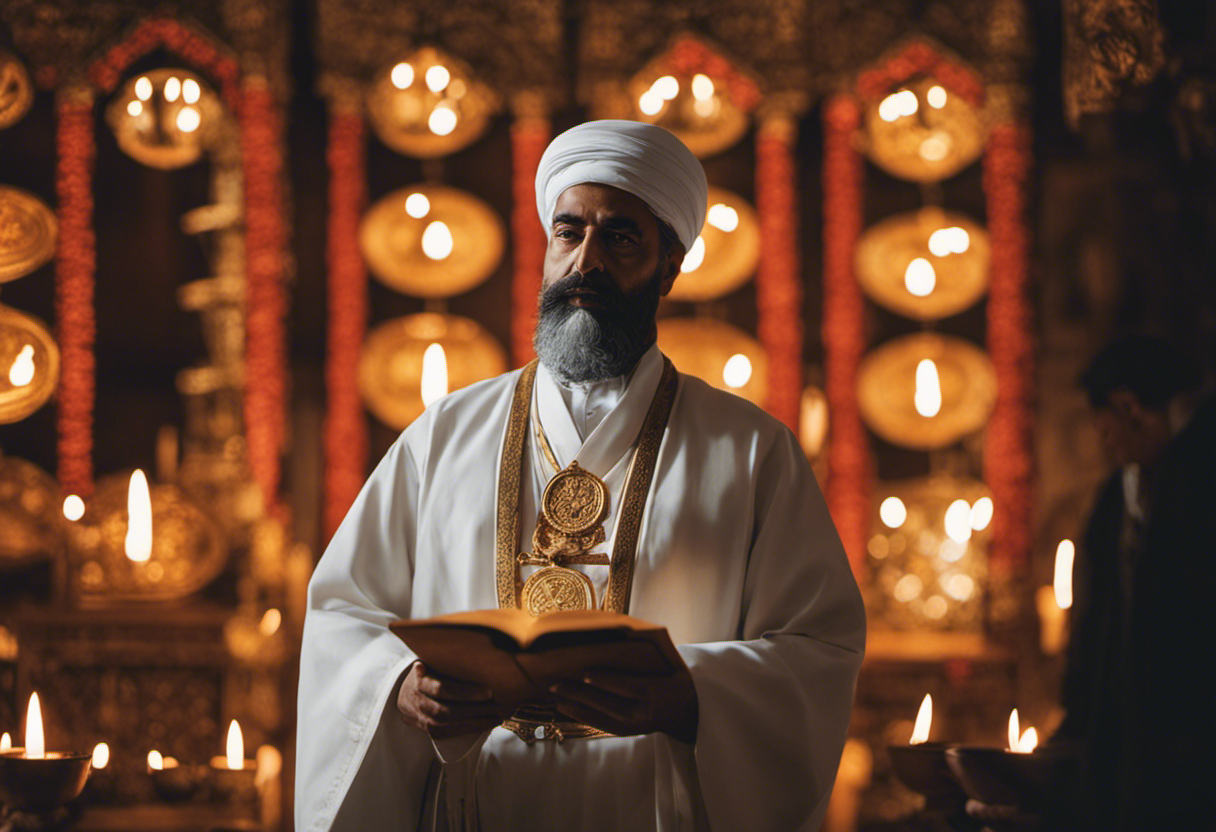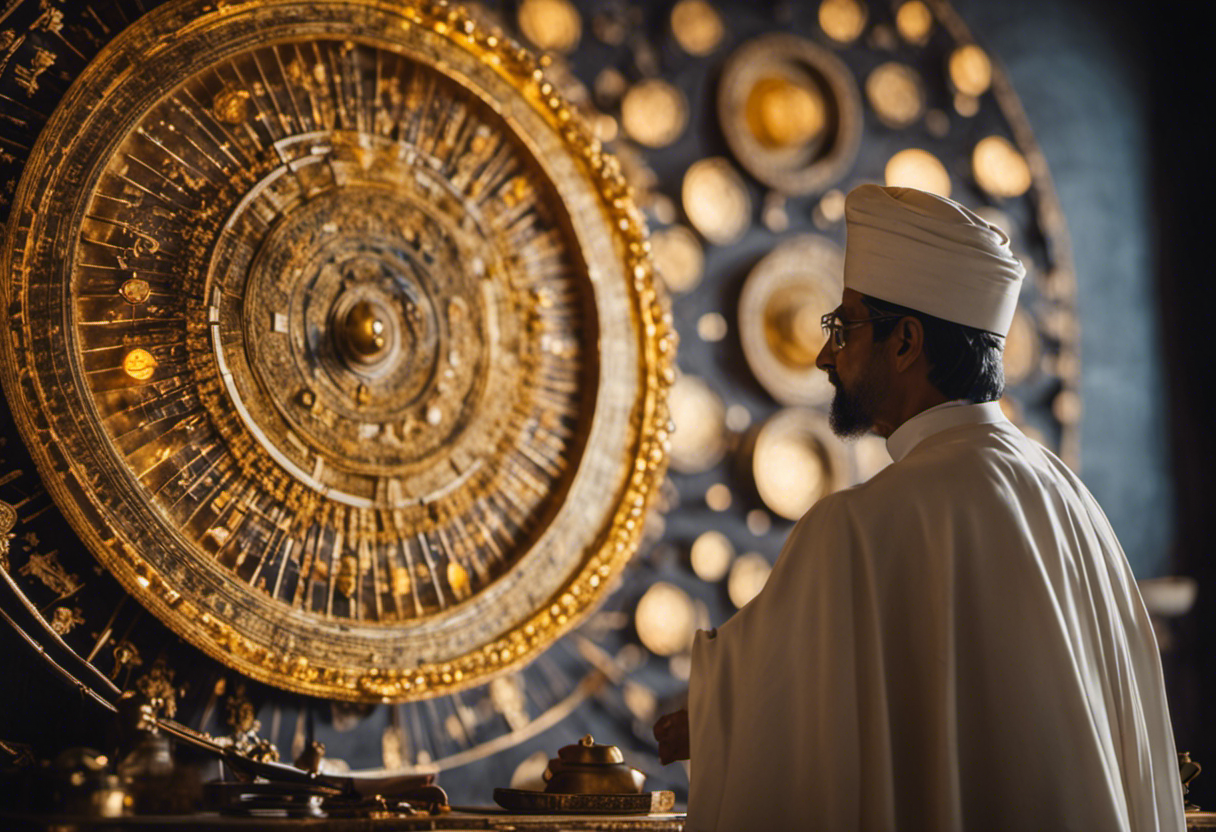In the realm of religious practices, few roles are as vital or as enigmatic as that of the priest. Within the intricate framework of the Zoroastrian calendar, priests assume a central position, diligently ensuring its accuracy and alignment with celestial events.
This article delves into the historical significance of the Zoroastrian calendar, the meticulous training of priests, and the rituals employed to maintain its precision. By examining the role of these knowledgeable individuals, we gain insight into the challenges and innovations associated with preserving this ancient calendar system.
Key Takeaways
- The Zoroastrian calendar has existed for over 3,000 years and has had a significant influence on various cultures.
- Priests undergo extensive training to ensure the accuracy of the Zoroastrian calendar, including understanding rituals, ceremonies, and complex astrological calculations.
- Rituals and ceremonies in Zoroastrianism are integral to the community, helping to connect with the divine and maintain religious and cultural heritage.
- Astrological calculations are crucial for the accurate determination of celestial events and festival dates in the Zoroastrian calendar, requiring extensive training in astrology.
Historical Significance of the Zoroastrian Calendar


One of the most important aspects of the current discussion on the historical significance of the Zoroastrian Calendar is the recognition of its over 3,000 years of existence and its influence on various cultures throughout history. The Zoroastrian Calendar, also known as the Iranian Calendar, has played a crucial role in the religious and cultural practices of the Zoroastrian community. It is closely linked to the significance of Zoroastrian festivals and the religious observances associated with them.
The historical developments of the Zoroastrian Calendar can be traced back to ancient Persia, where it was initially established by the prophet Zoroaster. Over the centuries, the calendar underwent several modifications and adaptations, reflecting the changes in religious beliefs and political developments in the region. The calendar is based on the solar year and consists of twelve months, each with thirty days. To account for the remaining five or six days, intercalary days, known as Gatha days, are added at the end of the year.
The Zoroastrian Calendar not only served as a tool for tracking time and organizing religious festivals but also played a crucial role in the agricultural practices of the ancient Persians. The calendar helped determine the appropriate times for sowing and harvesting crops, ensuring the prosperity and well-being of the community. This practical aspect of the calendar further highlights its significance and impact on the daily lives of the Zoroastrian people.
The Priestly Training for Calendar Maintenance


The maintenance of the Zoroastrian calendar is a crucial responsibility of the priests, who undergo extensive training to ensure its accuracy. This training encompasses the understanding and execution of specific rituals and ceremonies associated with calendar maintenance.
Additionally, priests are trained in the complex astrological calculations required to determine the dates of important religious festivals and observances. The rigorous training of priests in these areas reflects the religious significance and traditions attached to the Zoroastrian calendar.
Rituals and Ceremonies
During the priestly training for calendar maintenance, rituals and ceremonies are taught as essential practices. These rituals and ceremonies play a significant role in modern Zoroastrian communities and have a profound cultural impact.
The first sub-topic is the significance of rituals and ceremonies in modern Zoroastrian communities:
- Rituals and ceremonies are integral to the practice of Zoroastrianism and are observed by the community members.
- These rituals serve as a means of connecting with the divine and fostering a sense of communal identity.
- They are performed to mark significant events such as births, weddings, and deaths, as well as religious festivals and holy days.
The second sub-topic is the cultural impact of Zoroastrian calendar rituals:
- Calendar rituals help to maintain the religious and cultural heritage of the Zoroastrian community.
- They provide a structured framework for religious observance and ensure the continuity of traditions across generations.
- These rituals also promote a sense of unity and solidarity among community members, reinforcing their shared values and beliefs.
Astrological Calculations
Astrological calculations play a crucial role in the priestly training for calendar maintenance, as they enable accurate determination of significant celestial events. In the Zoroastrian tradition, priests are responsible for maintaining the Zoroastrian calendar, which is based on the movements of celestial bodies.
The calendar is used to determine the dates of important religious festivals and rituals. Astrological predictions are used to identify auspicious times for conducting ceremonies and to ensure that the calendar is aligned with the natural rhythms of the cosmos.
Priests undergo extensive training in astrology to acquire the knowledge and skills required for accurate calculations. They study celestial movements, planetary positions, and other astronomical phenomena to make precise predictions.
Religious Significance and Traditions
While discussing religious significance and traditions, it is important to highlight the meticulous priestly training required for maintaining the Zoroastrian calendar. The Zoroastrian calendar plays a crucial role in the religious practices and cultural traditions of the Zoroastrian community.
Here are three key aspects of the priestly training related to the Zoroastrian calendar:
-
Astrological Knowledge: Priests undergo extensive training in astrology to accurately calculate the positions of celestial bodies and determine the auspicious times for religious ceremonies and rituals.
-
Linguistic Expertise: Priests learn ancient Avestan language to understand and interpret the ancient texts and scriptures that guide the Zoroastrian calendar.
-
Mathematical Precision: Maintaining the Zoroastrian calendar requires complex mathematical calculations to determine the exact dates and times for important religious events and festivals.
The meticulous training of priests ensures the accurate observance of religious practices and the preservation of cultural traditions within the Zoroastrian community.
Calculating the Start of the Zoroastrian Year


Priests meticulously carry out the intricate calculations required to determine the onset of the Zoroastrian year. The Zoroastrian calendar, known as the Shahenshahi calendar, follows a solar calendar system and is based on the vernal equinox. The calculation of the Zoroastrian year involves determining the exact moment when the sun crosses the celestial equator, marking the start of spring. This is a significant event in Zoroastrianism, as it represents the renewal of life and the triumph of good over evil.
The role of priests in calculating the start of the Zoroastrian year is crucial, as it ensures the accuracy of religious festivals and ceremonial events. Priests have been entrusted with the responsibility of maintaining the Zoroastrian calendar for centuries, passing down their knowledge from one generation to the next. They carefully observe and record celestial movements, using astronomical instruments and ancient mathematical formulas to calculate the precise moment of the vernal equinox.
The determination of the Zoroastrian year has been subject to theological debates and cultural adaptations throughout history. As Zoroastrianism has spread to different regions and interacted with different cultures, adjustments have been made to accommodate local customs and traditions. For example, in India, Zoroastrians have adopted the Shenshai calendar, which takes into account the local solar year. Such adaptations demonstrate the flexibility of Zoroastrianism in incorporating cultural practices while maintaining its theological principles.
Aligning Celestial Events With Religious Observances


The alignment of celestial events with religious observances is of great significance in many cultures and religions. It allows for the synchronization of religious festivals and rituals with astronomical events such as solstices, equinoxes, and lunar phases.
This alignment not only adds a deeper spiritual meaning to these observances but also highlights the role of priests in ensuring the accurate timing of these events based on astronomical calculations and observations.
Astronomical Significance of Festivals
Regularly, the Zoroastrian festivals are celebrated with keen awareness of their astronomical significance, as they align religious observances with celestial events. The Zoroastrian calendar is based on the observation of astronomical phenomena, which plays a crucial role in determining the timing of festivals and religious rituals.
Here are three key ways in which astronomical observations are significant in Zoroastrian festivals:
-
Determining the dates: Zoroastrian priests rely on celestial phenomena, such as the position of the sun and moon, to calculate the dates of festivals. This ensures that the festivals are aligned with specific astronomical events, such as equinoxes or solstices.
-
Symbolism and rituals: The celestial events observed during festivals hold symbolic meanings in Zoroastrianism. For example, the spring equinox symbolizes the renewal of life and the triumph of light over darkness, which is celebrated during the festival of Nowruz.
-
Spiritual connection: The alignment of religious observances with celestial events creates a deeper spiritual connection for Zoroastrians. By acknowledging the interconnectedness of the physical and spiritual realms, these festivals serve as a reminder of the divine order and the harmony of the universe.
Overall, the astronomical significance of Zoroastrian festivals enhances the religious experience and deepens the understanding of the cosmic forces at play in the Zoroastrian faith.
Priestly Responsibility for Alignment
It is imperative for priests to diligently ensure the alignment of celestial events with religious observances in order to maintain the spiritual integrity of Zoroastrian festivals.
The Zoroastrian calendar is closely tied to celestial observations, with festivals and rituals being scheduled based on the positions of the sun, moon, and stars.
Priests have a crucial role in accurately determining these celestial events and communicating them to the community. This responsibility falls under the broader category of priestly duties, which include performing rituals, leading prayers, and interpreting religious texts.
By meticulously observing the skies and coordinating the timing of festivals accordingly, priests ensure that Zoroastrian religious practices remain in harmony with the natural world and uphold the traditions and beliefs of the community.
Their expertise in celestial observations is crucial for maintaining the authenticity and sanctity of Zoroastrian festivals.
Rituals for Maintaining Calendar Accuracy


Efficaciously, adhering to meticulously crafted rituals allows for the accuracy of the Zoroastrian calendar to be upheld and meticulously maintained. The rituals for maintaining calendar accuracy play a crucial role in the Zoroastrian religious tradition, ensuring that the calendar remains aligned with celestial events and seasons. These rituals involve the active participation of Zoroastrian priests who are entrusted with the responsibility of upholding the accuracy of the calendar.
-
Ritual Observance: Zoroastrian priests meticulously observe specific rituals at designated times to mark the beginning and end of each month. These rituals are performed with great precision and attention to detail, ensuring that the calendar remains accurate.
-
Astronomical Observations: Zoroastrian priests closely monitor celestial events such as the solstices and equinoxes to determine the dates for important religious festivals and observances. This careful observation enables them to adjust the calendar accordingly, maintaining its accuracy.
-
Intergenerational Transmission: Zoroastrian priests pass down their knowledge and expertise in calendar maintenance through generations. This ensures the continuity of the rituals and the accuracy of the calendar over time.
The rituals for maintaining calendar accuracy in Zoroastrianism reflect the commitment of the community to the preservation of their religious traditions. By meticulously adhering to these rituals, Zoroastrians ensure that their calendar remains a reliable guide for religious observances and cultural celebrations.
The Role of Priests in Determining Important Dates


Zoroastrian priests actively engage in assessing celestial events to accurately ascertain the dates of important religious festivals and observances. Their role in determining these dates is essential, as it not only strengthens their priestly authority but also fosters community involvement in religious activities.
Priestly authority is deeply rooted in the Zoroastrian tradition, as priests are considered the intermediaries between the divine and human realms. They are responsible for maintaining the sacred fire, performing rituals, and preserving the purity of the community. By actively engaging in the assessment of celestial events, priests demonstrate their expertise and knowledge, further solidifying their authority within the community.
Furthermore, the involvement of the community in the determination of important dates enhances their sense of belonging and participation in religious observances. Zoroastrianism places great emphasis on community and collective rituals, and the accurate determination of festival dates ensures that the entire community can come together to celebrate and honor their religious traditions.
Challenges and Innovations in Calendar Preservation


The preservation of calendars poses challenges due to the need for accurate record-keeping and the constant evolution of timekeeping methods. In order to maintain the integrity of calendars, various challenges must be overcome and innovative solutions must be implemented.
Some of the challenges faced in calendar preservation include:
- Accuracy: Ensuring that the recorded dates and events are precise and reliable.
- Cultural and historical context: Understanding the significance of certain dates and events in different cultures and historical periods.
- Technological advancements: Adapting to new technologies and incorporating them into the calendar systems.
To address these challenges, several innovative approaches have been developed:
- Digital calendars: The use of digital platforms and applications to create, store, and update calendars has revolutionized the process of record-keeping.
- Standardization: The establishment of standardized calendar systems, such as the Gregorian calendar, has facilitated global communication and coordination.
- Collaborative efforts: Collaborative projects involving scholars, historians, and experts from different fields have contributed to the preservation and interpretation of calendars.
Conclusion
In conclusion, the priests play a crucial role in maintaining the Zoroastrian calendar through their historical knowledge, training, and rituals.
They calculate the start of the Zoroastrian year and align celestial events with religious observances.
The priests also determine important dates, ensuring the accuracy of the calendar.
However, they face challenges in preserving the calendar and have been innovative in finding solutions.
Their dedication and expertise contribute to the preservation of this significant aspect of Zoroastrian religious practice.



